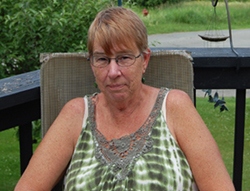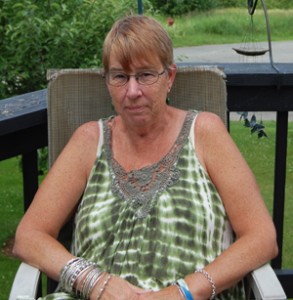

copyright the Chronicle July 2, 2014
by Tena Starr
BARTON — Nearly eight years ago, Kathy White of Barton decided she’d like to “pay it forward,” as she put it. “I wanted to find something I could do that had meaning,” she said in a recent interview.
That desire led her to become a guardian ad litem, or a GAL, a person who volunteers his or her time to represent the interests of “children in need of care or supervision” (CHINS).
That could involve anything from a nasty divorce to a situation where a family can’t properly care for a child anymore. The Guardian Ad Litem Program’s mission statements says its goal is to make sure that children and their families receive “appropriate services in a timely manner; that case plans and court decisions are based on the child’s best interests; and every child has a safe, stable and permanent home within a reasonable period of time.”
“Kids have always been very important to me,” Ms. White said. She’s a former Barton town clerk, a school board member, and she used to work for the State Police, so court proceedings didn’t intimidate her. GALs represent the interests of their young charges in Family Court proceedings.
It seemed a good fit for Ms. White, and it has been.
At the moment, she’s representing four teenage boys and says she’d take every one of them home with her if she could. But she’s learned to suffice with little things — like the hug she got from one of her clients when she made him a birthday cake recently.
That spontaneous hug was the boy’s first, Ms. White said, and it meant a lot.
“It’s probably one of the most frustrating, rewarding things I’ve ever done,” she said about her career as a GAL.
She emphasizes the “rewarding” part of that statement. The only really frustrating aspect of the work is how slow the process can sometimes be, she said.
The rewards can arrive slowly, too, but they’re substantial, Ms. White said.
She feels that she’s taken seriously in court proceedings, and that her work has made a difference in the lives of the young people, and their families, who she’s worked with.
Vermont’s Guardian Ad Litem Program hopes to find more people like Ms. White. The program constantly needs more volunteers.
“Hundreds suffer abuse, neglect, or abandonment by parents or caretakers,” the program’s website says. “Some are in turmoil due to parental separation or divorce. Others are exposed to domestic violence in their homes. Many more are in foster care for extended periods while waiting for a safe, permanent home.
“Many of the nearly 2,000 youngsters in court on delinquency charges are past victims of abuse or neglect. These Vermont children and youth need an adult to advocate for their best interests during Family Court proceedings. They need a guardian ad litem.”
It’s a state mandate that guardians ad litem be appointed to represent children, said Vermont GAL Program Recruitment Coordinator Jill Remby. “Since it’s a mandate, we really need to have a pool of volunteers.”
In Chittenden County, there’s usually no shortage, Ms. Remby said. “In your neck of the woods, it’s a struggle. We’re always recruiting.”
GALs receive training and are paid for mileage.
“It’s a commitment,” Mr. Remby said. “It’s not your typical volunteer job. It’s a real commitment to these kids and to the families. It takes a special person to do this work.”
Ms. White has represented kids in all kinds of situations — divorces, custody cases, children in state care. Like herself, the Vermont Department of Families and Children (DCF), when it’s involved, is also charged with representing the interests of the children.
But sometimes, Ms. White said, it helps to have a variety of perspectives. If it all works like it’s supposed to, all the players, which could include DCF, attorneys, parents, maybe counselors, work together to come up with the best solution for the children, she said.
“It’s the job of everybody on the team to do what’s in the best interest of the child,” Ms. White said. “But the GAL is the only pony in the show” who has no other role, no other interest than that of the child. “The GAL participates in trying to find the right outcomes for the child.”
A GAL is probably less emotional than parents in such situations, she said. And sometimes the children find it easier to talk to their GAL than to other adults involved.
“I currently have all teenaged boys,” Ms. White said with a smile. “What I think is in their best interests may not be what they think is in their best interests.”
She thinks of her work as common sense parenting, the big difference being that the children don’t live under her roof — not that she’d mind if they did. “I do get attached,” she said.
There’s no such thing as a typical case. “I’ve had cases where the parents gave up the child, and cases where the child has made some bad choices, and the parents recognized that they can’t provide what’s needed for the child. My very first case had to do with infants. In the end, parental rights were terminated, meaning the babies were moved to foster care.”
The commitment can be long-term — she’s represented one young man for five years. “It’s not always a one-time thing,” Ms. White said.
That particular young person has been in state custody most of his life, she said. “He’s a wonderful young man. He’s come a long way with the services that have been offered to him. He’s in a good place.”
She sees progress in the young people she works with, and is proud of them. She also finds it rewarding to see progress in their families.
“I had a mom, and she knew how to be a friend, but not how to be a mom,” Ms. White said. “She didn’t know how to say no.”
But that’s changed, she said, and the woman has begun to understand that discipline and structure are big parts of being a parent.
“A lot of these kids don’t have that foundation because their parents didn’t have it,” she said.
She views her job as a GAL as playing a role in breaking the negative cycle that some families can get stuck in.
There are never enough GALs, Ms. White said. She’s taken kids from Orleans and Essex counties, and has been asked to take one from Caledonia County. She’s had as many as 12 children at a time, she said.
The amount of time a GAL invests can vary widely, depending on how much he or she wants to spend, Ms. White said.
She, personally, wants to be very much involved. So she attends all team meetings and makes herself accessible to the kids and families, by phone and e-mail. She might visit the child’s pediatrician and foster parents.
Ms. White is also education surrogate for three of her four current kids. That means she’s responsible for making decisions about their education.
Sometimes a foster parent is not the best choice as an education surrogate, she noted, because children don’t always stay in the same foster home and may end up changing school districts.
The time commitment for a GAL is, to some extent, what you want it to be, Ms. White said. Volunteers can play a minimal role, or be immersed, as she is.
“It’s worth it, though,” she said. “It’s so worth it.”
She can’t emphasize enough that the experience has enriched her life.
For more information about the program, or to apply to be a GAL, contact Ms. Remby at [email protected], or visit the website at www.vermontjudiciary.org/GTC/Family/GAL.aspx.
contact Tena Starr at [email protected]
For more free articles from the Chronicle like this one, see our Featuring pages. For all the Chronicle’s stories, pick up a print copy or subscribe, either for print or digital editions.







